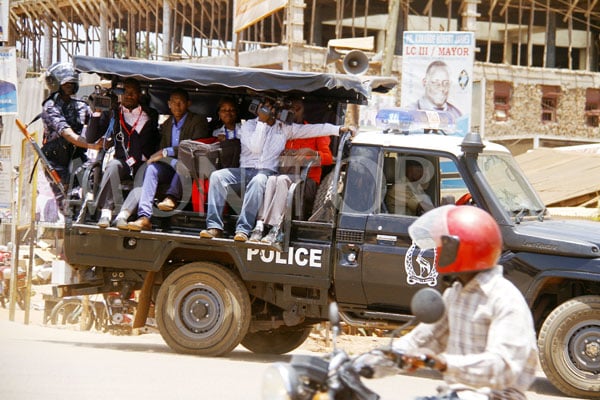New report puts journalists top on list of rights abuse victims

Journalists on a police pick-up truck after they were arrested near the home of Opposition activist Dr Kizza Besigye in Kasangati, Wakiso District, on April 27, 2016. PHOTO | ABUBAKER LUBOWA
What you need to know:
- Mr Alfred Oryem, the project coordinator at Northern Uganda Media Club (NUMEC), said journalists in the region are often targeted for covering sensitive topics such as land conflicts, human rights violations, corruption, politics, and security.
The African Centre for Media Excellence (ACME) has released a report, putting journalists and media practitioners atop the list of victims of threats to freedom of expression.
The findings of study conducted between August 2022 and August this year indicate that 61 percent of the victims were journalists, 21 percent were politicians and 9 percent were activists. Ordinary people and medical interns made up 5 percent and 4 percent respectively, of the total incidents recorded.
The report, which was released in Gulu City on September 20, further revealed that a total of 103 people were arrested or detained within the same period deliberately to subdue them not to express themselves.
Of these, the biggest number were politicians (33), followed by activists (25) and journalists (20).
The other categories of arrests/detentions included medical interns (15) and ordinary persons (10).
“A total of 24 people sustained injuries from the assaults, the majority being journalists (21) and there were three politicians who also sustained injuries. The majority of the victims were male, comprising 81 percent while women constituted 19 percent of the total incidents,” the report reads in part
Mr Brian Ssenabulya, a research and media monitoring assistant at ACME, noted that the student was conducted to fight impunity by tracking perpetrators of freedom violations with a view to holding them to account.
According to him, police were the biggest perpetrators with 30 cases (representing 53 percent), followed by other state security agencies, unknown individuals, political party members, lawyers, media managers, media owners and central government officials.
“Of the 30 cases perpetrated by police, 11 were against journalists or media practitioners, another 11 against politicians or political actors, four against activists while two were against ordinary persons and another two incidents against medical interns,” he said in an interview.
Mr Alfred Oryem, the project coordinator at Northern Uganda Media Club (NUMEC), told Monitor in an interview that journalists in the region are often targeted for covering sensitive topics such as land conflicts, human rights violations, corruption, politics, and security.
Mr Oryem added that journalists in the region also face intimidation and violence from the security forces, local authorities, politicians, businessmen, cultural leaders, and armed groups.
“In 2022 alone, NUMEC recorded 32 cases of violations against journalists in northern Uganda, including physical attacks, arrests, detentions, threats, harassment, censorship, confiscation of equipment, and denial of access to information,” he said.
In response to the safety challenges faced by journalists in the region, NUMEC established a safety desk in April 2022.
Mr Oryem said the safety desk works in collaboration with other stakeholders such as the Human Rights Network for Journalists-Uganda (HRNJ-U), ACME, the Collaboration on International ICT Policy for East and Southern Africa (CIPESA), the police, and the Uganda Communications Commission (UCC).



